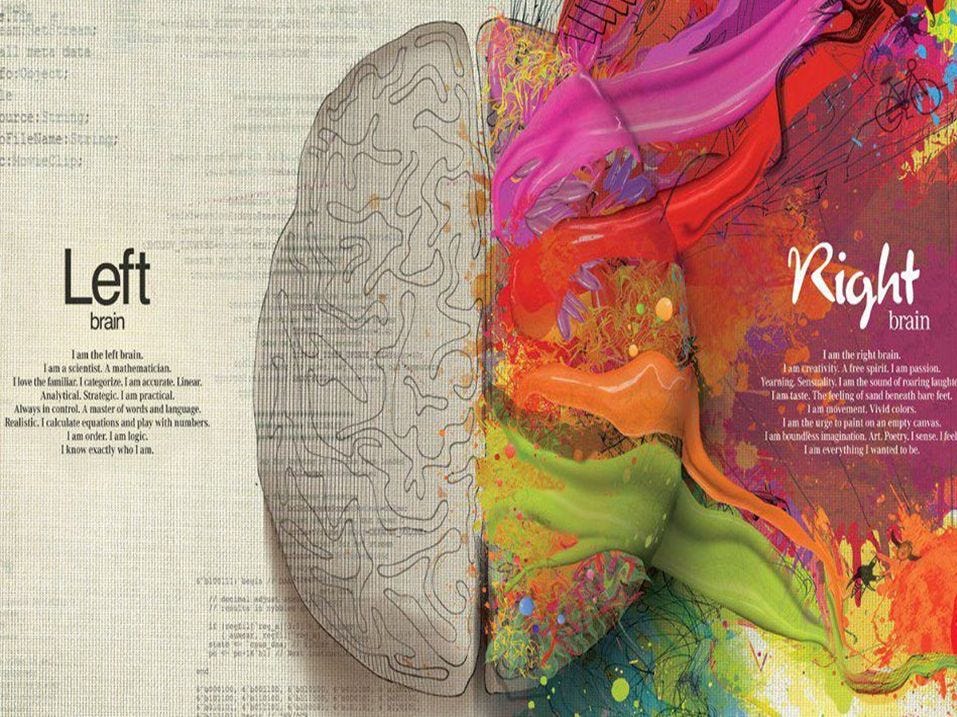In the search for understanding the brain and how it relates to people’s abilities and dispositions, there is a desire to identify “types” of people. Whether it’s left or right brained, INTJ or ESFP, or visual versus non-visual thinker, we develop overly simplistic tests that supposedly determine people’s abilities based on the way their brain functions. Personally, my results from these tests would indicate difficulty with logical thinking and computation, but as a math major I can tell you that this is untrue.

Overly Simplistic Model: Left vs. Right Brained (Fabel)
As described by Wikipedia, visual thinking is “the phenomenon of thinking through visual processing [or] seeing words as a series of pictures.” Conversely, non-visual thinkers “think exclusively in words.” According to Laura Otis, visual and non-visual (or verbal) thinking were cast as opposites for a long time, but new studies show that this is not the case.

Verbal vs. Visual (Ammer)
While papers like “Visualization and Mathematical Giftedness” indicate an advantage of non-visual thinkers in high school mathematics, these findings are likely heavily affected by the way math is taught in school. A visual thinker may be gifted in math but unable to realize these gifts when asked to apply a non-visual approach which may be uncomfortable and disadvantageous. Furthermore, Jean Plough finds that visual learning strategies, when applied in classrooms, can actually help students understand science. Additionally, according to Caren Walker and colleagues, students with a foundation in visual arts are well equipped to solve geometric problems because of honed spatial awareness.
These studies are a testament to the idea that both types of thinkers can succeed across disciplines, more specifically, the fields of math and science that usually emphasize non-visual, logical, verbal thinking. Terrance Tao, a UCLA professor and modern mathematical genius is famously unable to implement visual thinking; conversely, Albert Einstein used visual thinking almost entirely. Clearly, both made brilliant contributions to physics and mathematics, but used different approaches.

Albert Einstein (Zitelmann)
While understanding a person's cognitive habits and brain patterns can be helpful in understanding their unique way of problem solving, it's dangerous to put people in disciplinary confines based on this information.
Ammer, Ralph. “Verbal Visual.” Ralph Ammer, https://ralphammer.com/seeing-vs-reading/. Accessed 11 May 2021.
Fabel, Austin. “Left vs Right Brain.” Medium, https://medium.com/@austinfabel/the-right-brain-vs-the-left-brain-do-we-have-a-choice-fbf997bdf564. Accessed 11 May 2021.
Otis, Laura. “A New Look at visual thinking.” Psychology Today, https://www.google.com/amp/s/www.psychologytoday.com/us/blog/rethinking-thought/201602/new-look-visual-thinking%3famp. Accessed 11 May 2021.
Plough, Jean. Students Using Visual Thinking to Learn Science in a Web Based Environment. 2004. Drexel University, PhD Dissertation.
Presmeg, Norma. “Visualization and Mathematical Giftedness.” Educational Studies in Mathematics, vol. 17, 1986, pp. 297-311.
“Visual Thinking.” Wikipedia, https://en.m.wikipedia.org/wiki/Visual_thinking. Accessed 11 May 2021.
Walker, Caren et al. “Visual Thinking: Art Students Have an Advantage in Geometric Reasoning.” Creative Education, vol. 2, no. 1, 2011, pp. 22-26.
Zitelmann, Rainer. “Einstein.” Forbes, https://www.forbes.com/sites/rainerzitelmann/2019/08/26/self-marketing-geniuses-the-wisdom-of-albert-einstein-and-stephen-hawking/?sh=92c666c14886. Accessed 11 May 2021.


I really enjoyed your blog. I liked the comparison of professor Tao and Albert Einstein you gave in regards to how both types of thinkers can be successful in scientific and mathematic fields, despite differing in approaches. I also believe it is important that public education in the future implement teaching methods that allows both verbal and visual thinkers to learn comfortably instead of confining students to a singular teaching method.
ReplyDelete